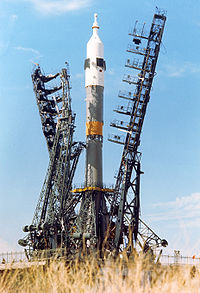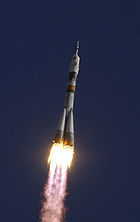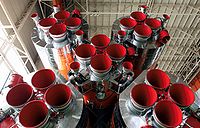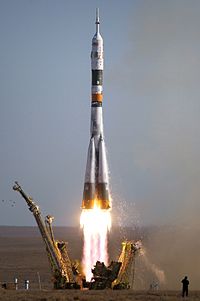- Soyuz (rocket family)
-
Soyuz 
A Soyuz-U on the launch pad, ahead of the Soyuz 19 (ASTP) launch on 1975-07-15Function Carrier rocket Manufacturer OKB-1
TsSKB-ProgressCountry of origin  Soviet Union
Soviet Union
 Russia
RussiaSize Stages 2 Associated rockets Family R-7 Launch history Status Active Launch sites Baikonur, Sites 1/5 & 31/6
Plesetsk Sites 41, 16 & 43 & ESA's Guiana Space CentreMaiden flight 28 November 1966 Notable payloads Soyuz
ProgressSoyuz (Russian: Союз, meaning "union", GRAU index 11A511) is a family of expendable launch systems developed by OKB-1, and manufactured by TsSKB-Progress in Samara, Russia. According to the European Space Agency, the Soyuz launch vehicle is the most frequently used and most reliable launch vehicle in the world.[1]
The Soyuz vehicles are used as the launcher for the manned Soyuz spacecraft as part of the Soyuz program, as well as to launch unmanned Progress supply spacecraft to the International Space Station and for commercial launches marketed and operated by Starsem and Arianespace. All Soyuz rockets use RP-1 and liquid oxygen (LOX) propellant, with the exception of the Soyuz-U2, which used Syntin, a variant of RP-1, with LOX. In the United States, it has the Library of Congress designation A-2. The Soyuz family is a subset of the R-7 family.
Contents
History
The launcher was introduced in 1966, deriving from the Vostok launcher, which in turn was based on the 8K74 or R-7a intercontinental ballistic missile. It was initially a three-stage rocket with a Block I upper stage. Later a Molniya variant was produced by adding a fourth stage, allowing it to reach the highly elliptical molniya orbit. A later variant was the Soyuz-U.[2]
The production of Soyuz launchers reached a peak of 60 per year in the early 1980s. It has become the world's most used space launcher, flying over 1700 times, far more than any other rocket. It is a very old basic design, but is notable for low cost and very high reliability, both of which appeal to commercial clients.
In the early 1990s plans were made for a redesigned Soyuz with a Fregat upper stage. The Fregat engine was developed by NPO Lavochkin from the propulsion module of its Phobos interplanetary probes. Although endorsed by the Russian Space Agency and the Russian Ministry of Defence in 1993 and designated "Rus" as a Russification and modernisation of Soyuz, and later renamed Soyuz-2, a funding shortage prevented implementation of the plan. The creation of Starsem in July 1996 provided new funding for the creation of a less ambitious variant, the Soyuz-Fregat or Soyuz U/Fregat. This consisted of a slightly modified Soyuz U combined with the Fregat upper stage, with a capacity of up to 1,350 kg to geostationary transfer orbit. In April 1997, Starsem obtained a contract from the European Space Agency to launch two pairs of Cluster 2 plasma science satellites using the Soyuz-Fregat. Before the introduction of this new model, Starsem launched 24 satellites of the Globalstar constellation in 6 launches with a restartable Ikar upper stage, between September 22, 1999 and November 22, 1999. After successful test flights of Soyuz-Fregat on February 9, 2000 and March 20, 2000, the Cluster 2 satellites were launched on July 16, 2000 and August 9, 2000. Another Soyuz-Fregat launched the ESA's Mars Express probe from Baikonur in June 2003. Now the Soyuz-Fregat launcher is used by Starsem for commercial payloads. It is due to be replaced by the new launcher, now named Soyuz/ST (or Soyuz-2), which will have a new digital guidance system and a strongly modified third stage with a new engine. The first development version of Soyuz 2 called Soyuz-2-1a, which is already equipped with the digital guidance system, but is still propelled by an old third stage engine, started on November 4, 2004 from Plesetsk on a suborbital test flight, followed by an orbital flight on October 23, 2006 from Baikonur. The fully modified launcher (version Soyuz-2-1b) flew first on December 27, 2006 with the COROT satellite from the Baikonur Cosmodrome.
A long string of successful Soyuz launches was broken on October 15, 2002 when the unmanned Soyuz U launch of the Photon-M satellite from Plesetsk fell back near the launch pad and exploded 29 seconds after lift-off. One person from the ground crew was killed and eight injured. Another failure occurred on June 21, 2005, during a Molniya military communications satellite launch from the Plesetsk launch site, which used a four-stage version of the rocket called Molniya-M. The flight ended six minutes after the launch because of a failure of the third stage engine or an unfulfilled order to separate the second and third stages. The rocket's second and third stages, which are identical to the Soyuz, and its payload (a Molniya-3K satellite) crashed in the Uvatski region of Tyumen (Siberia).[3] On August 24, 2011, an unmanned Soyuz-U carrying cargo to the International Space Station crashed, failing to reach orbit.
Between February 1, 2003 and July 26, 2005 with the grounding of the US Space Shuttle fleet, Soyuz was the only means of transportation to and from the International Space Station. This included the transfer of supplies, via Progress spacecraft, and crew changeovers. Now that the Space Shuttle fleet is retired, the American space program is without any means to boost men into orbit, and NASA is entirely dependent on the Soyuz to send crew into space for the immediate future.
On 19 January 2005, the European Space Agency and the Russian Federal Space Agency agreed to launch Soyuz/ST rockets from the Guiana Space Centre.[4] The equatorial launch site will allow the Soyuz to deliver 2.7 to 4.9 tonnes into sun-synchronous orbit, depending on the third-stage engine used.[5] Construction of a new pad started in 2005 and was completed in April 2011. The pad used vertical loading common at Guiana, unlike the horizontal loading used at the Baikonur Cosmodrome.[6] A simulated launch was conducted in early May 2011.[7] The first operational launch happened on 21 October 2011, bearing the first two satellites in Galileo global positioning system.
Variants
See also: R-7 (rocket family)- Soyuz 11A511
- Soyuz-L 11A511L
- Soyuz-M 11A511M
- Soyuz-U 11A511U
- Soyuz-U2 11A511U2 or 11A511K
- Soyuz-FG 11A511U-FG
- Soyuz-2 14A14
The Molniya-M was also derived from the Soyuz family.
Assembling the rocket
 Soyuz rocket assembly: the first and second stages are in the background, already joined together; the third stage is in the lower left corner of the image. The Soyuz spacecraft, covered by its launch shroud, is in the lower right corner.
Soyuz rocket assembly: the first and second stages are in the background, already joined together; the third stage is in the lower left corner of the image. The Soyuz spacecraft, covered by its launch shroud, is in the lower right corner.
The rocket is assembled horizontally in the Assembly and Testing Building. The assembled rocket is transported to the launch site in its horizontal state and then raised. This is different from the vertical assembly of, for example, the Saturn V - one of the features which makes Soyuz cheaper to prepare for launch.
Assembling a horizontally positioned rocket is relatively simple as all modules are easily accessible. Also, assembling the rocket in vertical position would require a windproof highrise hangar, which was not considered economically feasible at the time the rocket was designed.
Launch pad
The entire rocket is suspended in the launch system by the load-bearing mechanisms on the strap-on boosters where they are attached to the central core. The latter rests on the nose sections of the strap-on boosters. This scheme resembles flight conditions when the strap-on boosters push the central core forward. The concept of suspending the rocket was one of the novelties introduced with the R-7/Soyuz.
Since the launch pad has been eliminated, the bottom portion of the missile is lowered. The launch system trusses bear the wind loads. Resistance to high wind is an important feature of the launch system, as the Kazakhstan steppes, where the Baikonur launch site is located, are known for windstorms.
Launch
During launch, the support booms track the movement of the rocket. After the support boom heads emerge from the special support recess in the nose sections of the strapons, the support booms and trusses disconnect from the rocket airframe, swiveling on the support axes and freeing the way for the rocket to lift off. During launch, the rocket and the launch facility form a single dynamic system.
When the strapon booster engines stop, the boosters fall away, providing nonimpact separation. If the skies are clear, ground observers can see a Korolyov cross formed by the falling boosters.
Fairings used for unmanned missions
The Soyuz LV[clarification needed] is used for various Russian unmanned missions and is also marketed by Starsem for commercial satellite launches. Presently the following fairing types are used:
Progress is the cargo spacecraft for unmanned missions to the ISS and previously to Mir. The spacecraft uses a dedicated platform and fairing and can be launched with either Soyuz-U, Souyz-FG or Soyuz-2.[citation needed]
A-type fairing is used for commercial launches.[citation needed]
S-type fairing is used for commercial launches by Starsem. The fairing has external diameter of 3.7 m and a length of 7.7 m. The Fregat upper stage is encapsulated in the fairing with the payload and a payload adapter/dispenser.[8] S-type fairing along with Fregat upper stage were used to launch the following spacecraft: Galaxy 14, GIOVE A, Mars Express, AMOS-2, Venus Express, Cluster.[9]
SL-type fairing is used for commercial launches by Starsem. The fairing has external diameter of 3.7 m and a length of 8.45 m. The Fregat upper stage is encapsulated in the fairing with the payload and a payload adapter/dispenser.[10] SL-type fairing along with Fregat upper stage were used to launch the following spacecraft: COROT.[citation needed]
ST-type fairing is used for commercial launches by Starsem. Its external diameter is 4.1 m and its length is 11.4 m. It can be used with the Soyuz-2 only, because older analog control system cannot cope with aerodynamic instability introduced by a fairing as large as this. This carbon-plastic fairing is based on the proven configuration used for Arianespace’s Ariane 4 vehicles, with its length increased by approximately one additional meter.[11] The fairing has been developed and is being manufactured by TsSKB-Progress in accordance with the requirements of a customer (Starsem).[12] This will be the only fairing type offered by Starsem/Arianespace for launches from Kourou.[13]
Stages
First stage
The first stage of Soyuz rockets consists of four identical conical liquid booster rockets, strapped to the second stage core. Each booster has a single rocket motor with four combustion chambers, two vernier combustion chambers, and one set of turbopumps.
Statistics (each of 4 boosters)[citation needed]
- Gross mass: 44.5 t (98,100 lbm)
- Propellant: 39.2 t (86,400 lbm)
- Dry mass: 3,784 kg (8,342 lbm)
- Diameter: 2.68 m (8 ft 10 in)
- Length: 19.6 m (64 ft 4 in)
- Burn time: 118 s
- Engines:
- Soyuz and Soyuz-U models
- Soyuz-ST models
- RD-117 (11D511)
- Thrust 838 kN (188 klbf) at liftoff
- Thrust 1021 kN (230 klbf) in vacuum
- Specific impulse 245 s (2.40 kN·s/kg) at liftoff (est)
- Specific impulse 310 s (3.04 kN·s/kg) in vacuum (est)
- Chamber pressure 5.85 MPa (848 psi)
- RD-117 (11D511)
- Soyuz-FG
- RD-117A (14D22)
- Thrust 775 kN (174 klbf) at liftoff
- Specific impulse 320.2 s (3.14 kN·s/kg) in vacuum
- RD-117A (14D22)
Second stage
The second stage of the Soyuz booster is a single, generally cylindrical stage with one motor at the base. Like each of the first-stage rockets, it also has four combustion chambers and one set of turbopumps, but four (instead of two) vernier combustion chambers. The second stage tapers toward the bottom to allow the four first stage rockets to fit more closely together.
- Gross mass: 105.4 t (232,400 lbm)
- Propellant: 95.4 t (210,000 lbm)
- Propellant (Soyuz-U2 with Syntin propellant): 96.4 t (212,000 lbm)
- Dry mass: 6,875 kg (15,160 lbm)
- Length: 28 m (91 ft 10 in)
- Diameter: 2.95 m (9 ft 8 in)
- Burn time: 290 s
- Engines:
- Soyuz and Soyuz-U models
- RD-108
- Thrust 779 kN (175 klbf) at liftoff
- Thrust 997 kN (224 klbf) in vacuum
- Specific impulse 264 s (2.59 kN·s/kg) at liftoff
- Specific impulse 311 s (3.05 kN·s/kg) in vacuum
- Chamber pressure 5.1 MPa (740 psi)
- RD-108
- Soyuz-U2 model with Syntin fuel
- RD-108
- Thrust 811 kN (182 klbf) at liftoff
- Thrust 1009 kN (227 klbf) in vacuum
- Specific impulse 264 s (2.59 kN·s/kg) at liftoff
- Specific impulse 311 s (3.05 kN·s/kg) in vacuum
- Chamber pressure 5.1 MPa (740 psi)
- RD-108
- Soyuz-ST models
- RD-118 (11D512)
- Thrust 792 kN (178 klbf) at liftoff
- Thrust 990 kN (222 klbf) in vacuum
- Specific impulse 264 s (2.59 kN·s/kg) at liftoff (est)
- Specific impulse 311 s (3.05 kN·s/kg) in vacuum (est)
- Chamber pressure 5.85 MPa (848 psi)
- RD-118 (11D512)
- Soyuz and Soyuz-U models
Third stage
There are two variant upper stages in use, the Block I and Improved Block-I (used in Soyuz-2-1b).
- Gross mass: 25.2 t (55,600 lbm)
- Propellant: 21.4-22.9 t (47,200–50,500 lbm)
- Dry mass: 2355 kg (5190 lbm)
- Length: 6.7 m (22 ft 0 in)
- Diameter: 2.66 m (8 ft 9 in)
- Burn time: 240 s
- Engine:
- Block I
- RD-0110
- Thrust 298 kN (67.0 klbf)
- Specific impulse 330 s (3.24 kN·s/kg)
- Chamber pressure 6.8 MPa (986 psi)
- Improved Block I
- RD-0124 (11D451)
- Thrust 294 kN (66 klbf)
- Specific impulse 359 s (3.52 kN·s/kg)
- Chamber pressure 16.2 MPa (2350 psi)
- Block I
References
- ^ Soyuz launch vehicle: The most reliable means of space travel, ESA
- ^ ""Soyuz" - series launch vehicles". Samara Space Centre. http://www.samspace.ru/ENG/RN/ser_souz.htm.
- ^ "Molniya-M accident caused by engine failure or unfulfilled order". En.rian.ru. 2005-06-21. http://en.rian.ru/russia/20050621/40556511.html. Retrieved 2009-07-30.
- ^ "Closer ties between ESA and Russia". European Space Agency. 2005-01-19. http://www.esa.int/esaMI/industry_how_to_do_business/SEMBHY71Y3E_0.html. Retrieved 2011-05-06.
- ^ "Soyuz at the European Spaceport" (PDF). http://www.esa.int/esapub/bulletin/bulletin132/bul132h_arend.pdf. Retrieved 2011-05-06.
- ^ "Soyuz launch site ready for first flight". European Space Agency. 2011-04-01. http://www.esa.int/SPECIALS/Launchers_Home/SEMUE17UPLG_0.html. Retrieved 2011-05-06.
- ^ "First Soyuz almost ready for launch from French Guiana". European Space Agency. 2011-05-04. http://www.esa.int/esaCP/SEMYBDZ57NG_index_0.html. Retrieved 2011-05-06.
- ^ "Soyuz launch vehicle". Starsem. http://www.starsem.com/soyuz/soyuz.htm. Retrieved 2009-07-30.
- ^ "Soyuz-FG with Fregat upper stage". Federalspace.ru. http://www.federalspace.ru/Roket1Show.asp?RoketID=36. Retrieved 2009-07-30.[dead link]
- ^ "COROT launch kit" (PDF). http://www.starsem.com/news/images/Corot_launch_kit.pdf. Retrieved 2009-07-30.
- ^ "Arianespace/Soyuz/Overview". http://www.arianespace.com/launch-services-soyuz/soyuz-introduction.asp. Retrieved 2011-07-13.
- ^ "Novosti Kosmonavtiki". http://webcache.googleusercontent.com/search?q=cache:fUGGlWNesFYJ:www.novosti-kosmonavtiki.ru/phpBB2/viewtopic.php%3Fp%3D228722+%D0%A6%D0%A1%D0%9A%D0%91+%D0%9F%D1%80%D0%BE%D0%B3%D1%80%D0%B5%D1%81%D1%81+%2281%D0%9A%D0%A1%22&cd=1&hl=en&ct=clnk&gl=us&source=www.google.com. Retrieved 2011-07-14.
- ^ "Microsoft Word - _MU Soyuz-CSG Title June 2006.doc" (PDF). http://www.arianespace.com/launch-services-soyuz/Soyuz_Users_Manual_CSG_June06.pdf. Retrieved 2009-07-30.
Further reading
- International Reference Guide to Space Launch Systems, Third Edition, Iaskowitz, Hopkins, and Hopkins ed., 1999, Reston, Virginia, AIAA Publications. ISBN 1-56347-353-4
External links
- Starsem
- Soyuz launch log at Starsem
- Soyuz U/Fregat
- Soyuz launch vehicle: The most reliable means of space travel
- Soyuz Booster Family
Soviet, Russian and Ukrainian expendable launch vehicles Active In development Former Expendable launch systems Current Ariane 5 · Atlas V · Delta (II · IV) · Dnepr-1 · GSLV · H-IIA · H-IIB · Kaituozhe-1 · Kosmos-3M · Long March (1D · 2C · 2D · 2F · 3A · 3B · 3C · 4B · 4C) · Minotaur (I · IV) · Naro-1 · Paektusan · Pegasus · Proton (K · M) · PSLV · Rokot · Safir · Shavit · Shtil' · Start-1 · Strela · Soyuz (U · FG · 2) · Taurus · Unha · VLS-1 · Volna · Zenit (2 · 2M · 3SL · 3SLB)
Planned Angara · Athena (Ic · IIc) · GSLV III · Haas · Long March (5 · 6 · 7) · Minotaur V · RPS-420 · Rus-M · Soyuz-1 · Simorgh · TSLV · Taurus II · Tsyklon-4 · Vega · Zenit-3F
Previous Ariane (1 · 2 · 3 · 4) · ASLV · Athena (I · II) · Atlas (B · D · E/F · G · H · I · II · III · LV-3B · SLV-3 · Able · Agena · Centaur) · Black Arrow · Caleb · Conestoga · Delta (A · B · C · D · E · G · J · L · M · N · 0100 · 1000 · 2000 · 3000 · 4000 · 5000 · III) · Diamant · Energia · Europa · Falcon 1* · Feng Bao 1 · H-I · H-II · J-I · Juno I · Juno II · Kosmos (1 · 2I · 3) · Lambda (4S) · Long March (1 · 2A · 2E · 3 · 4A) · Mu (4S · 3C · 3H · 3S · 3SII · V) · N1 · N-I · N-II · Pilot · R-7 (Luna · Molniya (M) · Polyot · Soyuz (L · M · U2) · Soyuz/Vostok · Sputnik · Voskhod · Vostok (L · K · 2 · 2M)) · Saturn (I · IB · V · INT-21) · Scout · SLV · Sparta · Thor (Able · Ablestar · Agena · Burner · Delta · DSV-2U) · Thorad-Agena · Titan (II GLV · IIIA · IIIB · IIIC · IIID · IIIE · 34D · 23G · CT-3 · IV) · Tsyklon (2 · 3) · Vanguard
- - Falcon 1 designed for partial reuse, however recovery failed on the first three flights and remaining vehicles were flown expendably
R-7 rockets Main articles R-7 family · R-7 Semyorka
Rockets MissilesR-7 Semyorka · R-7A SemyorkaLaunch SystemsVostokLuna · Vostok-L · Vostok-K · Vostok-2 · Vostok-2MSoyuzLaunch sites Site 1/5 · Site 31/6Site 41/1 · Site 16/2 · Site 43/3 · Site 43/4ELSLaunches 1957-1959 · 1960-1964 · 1965-1969 · 1970-1974 · 1975-1979 · 1980-1984 · 1985-1989 · 1990-1994 · 1995-1999 · 2000-2004 · 2005-2009 · 2010-2014See also Categories:- 1967 in spaceflight
- 1968 in spaceflight
- 1969 in spaceflight
- 1970 in spaceflight
- 1971 in spaceflight
- 1972 in spaceflight
- 1973 in spaceflight
- Soyuz programme
- Space launch vehicles of the Soviet Union
- Space launch vehicles of Russia
- Soviet inventions
- Russian inventions
- R-7 rockets
Wikimedia Foundation. 2010.



